
“If you want to go fast, go alone; if you want to go far, go together.”
This African proverb is one of my favorites, as it captures the power of linking arms with others and moving forward in community to achieve a common goal. It serves as an inspiration to the Orange County Community Foundation as we partner with donors and organizations in the next five years to focus on six key areas for giving based on critical needs and issues in the county: economic opportunity, educational access, women’s health, youth mental health, environmental stewardship and community power building.
We have seen the profound impact of organizations and donors collaborating with us to support specific issues or causes over the decades, especially through our iheartOC Giving Days, an innovative initiative we developed 10 years ago.
OCCF’s Giving Days are nonprofit fundraising days that focus on a specific theme, from at-risk youth to our aging neighbors in need. We launched the first Giving Day as a single-day event encompassing the entire OC nonprofit sector and have transformed it over the years into a series of cause-focused campaigns that unite nonprofits, engage donors in new ways and demonstrate the power of community when aligned with a shared purpose.
As nonprofits are asked to do more with less, Giving Days can amplify their impact, turning one-day fundraising into a scalable, strategic and deeply collaborative movement.
As of December 2024, OCCF’s Giving Days have raised more than $35 million for local nonprofits since their inception in 2015, transforming the local philanthropic landscape along the way.
Here’s why we believe this model can become a blueprint for how nonprofits can leverage business strategies, digital tools and a collaborative ethos:
1. From Zero Sum to Collective Impact
At their core, OCCF’s Giving Days are a powerful example of business principles applied to the nonprofit sector, where competition for limited resources is inherent in traditional funding programs. We recognized early on that collaboration could outperform competition. By rallying nonprofits around a common cause—from homelessness, mental health, and youth empowerment to community belonging—organizations can work effectively side by side, championing one another’s success and building momentum through shared effort. This model leverages the business world’s best practices: coalition-building, strategic alignment and co-marketing.
The result? A more powerful impact that strengthens the entire philanthropic ecosystem.
Rather than each nonprofit navigating fundraising alone, they benefit from joint outreach, shared visibility, collective storytelling, co-branded messages, pooled donor awareness and the credibility of being part of a larger movement.
2. Empowering Nonprofits Through Digital Transformation
We learned that nonprofits are not only willing to embrace technology—they thrive while using it with the right support.
We lower the barrier to entry by underwriting critical assets like social media toolkits, digital templates and platform access. Nonprofits then take these tools and run with them, engaging their audiences online, creating custom content and tapping into peer-to-peer strategies that broaden their reach.
This model doesn’t dilute the nonprofit sector’s “high-touch” approach—it enhances it. By meeting donors where they are—digitally—while maintaining mission-driven messaging, organizations are expanding both their donor base and their digital fluency.
3. Donors Deepen and Broaden their Giving
Another powerful outcome of Giving Days is how it informs and engages donors. Rather than funneling support to a single familiar organization, donors are exposed to a portfolio of nonprofits working within a shared mission.
This discovery process allows donors to diversify their giving, support entire cause areas or even distribute funds across multiple organizations. One philanthropist, for instance, uses her OCCF donor-advised fund to support every nonprofit participating in campaigns such as Help Them Home, which focuses on helping the unhoused, and Imagining Mental Wellness, which supports mental health services in Orange County.
Giving Days acts as both an access point and a multiplier, inviting donors to engage more deeply and more broadly than they could on their own.
4. Board and Staff Engagement Drives Internal Action
Giving Days catalyze ownership and engagement among staff and board members at participating nonprofits. They aren’t just passively participating—they’re leading the charge.
• Radiant Futures participates in Love Is, a Giving Day focusing on mental wellness and healthy relationships, and forms internal staff teams that create excitement, spark friendly competition and encourage widespread outreach through peer-to-peer tools.
• WisePlace participates in Help Them Home, building personalized fundraising pages for board members and supporters to share their passion with their networks.
• HomeAid OC turns its board meetings into real-time giving sprints for Help Them Home, with members texting friends and monitoring live campaign leaderboards.
• Charitable Ventures used its first Giving Day participation as an occasion to activate its board with challenge grants and stretch goals.
This level of engagement among staff, boards and donors has a compounding effect: It increases donations, builds organizational capacity and strengthens the culture of giving inside each nonprofit.

